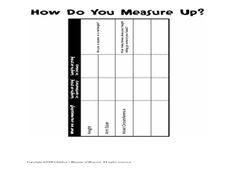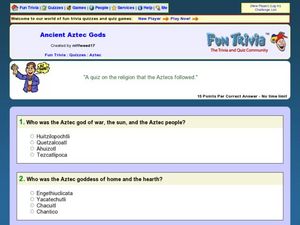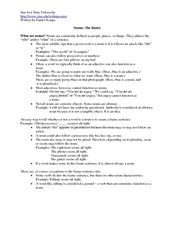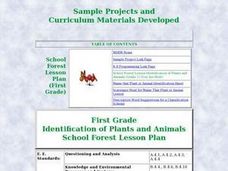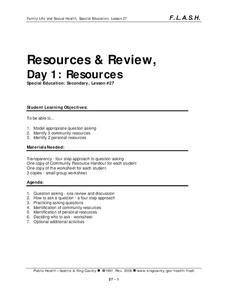Curated OER
Identifying Birds
Eighth graders identify and name birds in their school yard by comparing and contrasting pictures of 12 common birds in the Phoenix metro area using the Ecology Explorers Protocol. They formulate questions based on observations that lead...
Curated OER
Grocery Store Choices: Vocabulary in Conversation
In this online interactive English vocabulary skills worksheet, students answer 10 fill in the blank questions regarding grocery-related terms. Students may submit their answers to be scored.
Curated OER
How Do You Measure Up?
Students measure their body. In this measurement lesson plan, students use a string to measure their height and the circumference of their head. They record this information on the worksheet provided and answer questions as a group.
Curated OER
Allergy: A Modern Epidemic
In this allergies learning exercise, 7th graders 6 paragraphs about the topic, then answer 12 questions about the passage, complete a table with verbs and nouns from the text, work on 12 sentences and discuss 4 questions with a partner...
Curated OER
Ancient Aztec Gods
Are you working on a Central American civilizations unit? Give your class a quiz on the Aztec gods after studying the Aztec culture in social studies or literature. Fifteen questions focus on basic identification.
NY Learns
Culture Clash: Exploring Characters within El Bronx Remembered by ECSDM
Using a character map, learners assign traits to characters from Nicholasa Mohr’s El Bronx Remembered: A Novella and Stories. In addition, groups record evidence from the stories to justify the labels and use these sheets to prepare for...
Kenan Fellows
Determining Stream Health by the Diversity and Types of Benthic Organisms
How diverse are the benthic organisms found in local streams? Using the information learned in previous lessons on identification of macroinvertebrates and on calculating stream index values, groups determine the health of local...
Curated OER
Word Problems Solved By S.M.S.
Learners solve word problems with a consumer math emphasis. This lesson plan also contains many strategies and questions learners can ask to solving problems. There is also a bibliography included for resources on problem solving.
Curated OER
Smears
In this biology worksheet, students are shown how to prepare a smear and then answer some review questions that address the proper preparation of a sample.
Curated OER
Fractions
Fourth graders use pattern blocks and fraction identification cards to create and identify fractions. In this fractions lesson plan, 4th graders identify fractions in a pizza, and make fractions with markers.
Curated OER
European Integration: Who and Why?
This French IV-V lesson addresses European integration into the European Union. French language learners research, discuss, and present in the target language. Online research, discussion, and presentations will take approximately 5-7...
San José State University
Nouns: The Basics
Need to work on nouns with your class? This handout breaks down nouns and provides twelve sentences for noun identification practice. Help English language learners recognize nouns with the examples given on this handout.
Curated OER
Translate Animal Names: International Phonetic Alphabet 4
In this International Phonetic Alphabet instructional activity, students respond to 20 fill in the blank questions that require them to translate animal names to the International Phonetic Alphabet keys.
Curated OER
Translate Animal Names: International Phonetic Alphabet
In this International Phonetic Alphabet worksheet, students respond to 20 fill in the blank questions that require them to translate animal names to the International Phonetic Alphabet keys.
Curated OER
Translate Animal Names: International Phonetic Alphabet 2
In this International Phonetic Alphabet worksheet, students respond to 20 fill in the blank questions that require them to translate animal names to the International Phonetic Alphabet keys.
Curated OER
Reptile Identification Exercise
Learners are shown how to use the Digital Atlas of Idaho. They use a dichotomous key to identify species of Idaho reptiles. Students describe some basic life characteristics of reptiles. They use th visual key to identify the species...
Curated OER
Mineral Identification
Eighth graders examine the properties that are used to identify minerals and how they work. In this investigative lesson students use the six properties to identify minerals that they are given.
Curated OER
Identification of Plants and Animals
First graders identify a variety of plants and animals that can be found in the school forest, then differentiate between plants and animals. They find examples of characteristics used to differentiate between plants or animals.
Curated OER
Identification of Animals by Serum Electrophoresis
Students compare their unknown serum against a set of known serum standards and determine the animal source of their serum. They write a lab report to communicate their results.
Curated OER
Identifing Elements of Narrative Writing
Students explore the concepts of narrative writing. They identify the basic elements in narrative writing such as the setting description, characters, conflict, climax and resolution. Using five adjectives from a previous spelling unit,...
Curated OER
Who Am I? Fish Identification
In this science worksheet, learners examine 16 detailed pictures of different species of fish. Students identify each fish. There is no room to write the name under the picture. It is assumed this is an oral activity, although there are...
King Country
Lesson 27: Resources & Review - Day 1: Resources
To conclude a unit on family life and sexual health (FLASH), class members use the skills they have practiced in previous lessons to develop strategies for getting information or help when they need it.
Curated OER
Rock On! Featuring the Igneous, Sedimentary and Metamorphic Trio!
Get your classroom rocking with this four-lesson earth science unit. Through a series of shared reading activities and hands-on investigations, young geologists learn about the three types of rocks and the unique properties of each.
National Science Teachers Association
Hop into Action
Young scientists find out what makes amphibians such unique and interesting animals in this simple life science instructional activity. After looking at pictures and discussing the characteristics of amphibians, learners...


